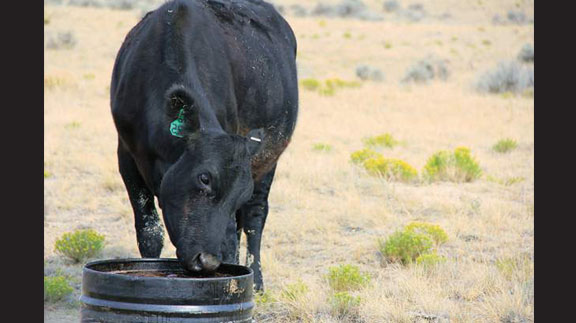Farm & Ranch
Cattle Trails Cow-Calf Conference set for Dec. 3 in Wichita Falls

Writer: Kay Ledbetter, 806-677-5608, [email protected]
Contacts: Stan Bevers, 940-552-9941, [email protected]
Marty New, 580-255-0546, [email protected]
WICHITA FALLS – After some tough drought-influenced years, cattlemen looking to return to efficient production should attend the Cattle Trails Cow-Calf Conference set Dec. 3 in Wichita Falls, according to a Texas A&M AgriLife Extension Service specialist.
“Ranchers in north Texas and southern Oklahoma have experienced highs and lows in 2015, but the one thing that they didn’t have to worry about was a severe drought that appears to have ended in 2014,” said Stan Bevers, AgriLife Extension economist in Vernon.
“Record rainfall in May filled tanks and lakes and caused rivers and creeks to run again,” Bevers said. “Grass was abundant as a result of the rainfall. Cattle prices remained high through August. Since August, ranchers have come to the realization that calf prices can and will move lower, probably for the next several years.”
Industry experts are recommending that ranchers become as efficient productively and financially as possible to operate in the coming years, he said.
Becoming as efficient as possible is the focus for this year’s Cattle Trails Cow-Calf Conference, Bevers said. Each speaker will address how ranchers can achieve efficient levels of production and financial success while minimizing risk.
The slogan of the annual conference is “driving your operation to profits,” however Bevers said the last few drought-influenced years have made it pretty tough.
“Returning to efficient production will require a new level of understanding and pencil pushing,” he said.
The conference, which alternates between Texas and Oklahoma each year, will be held from 8 a.m. to 3 p.m. at the MPEC Center, 1000 5th St. in Wichita Falls.
Registration is $25 per person and includes educational materials, a copy of the Cattle Trails Cow-Calf Conference materials, a noon meal and refreshments. Additional information can be found at http://agrisk.tamu.edu.
Producers are asked to preregister by contacting their local AgriLife Extension county agent, Oklahoma Cooperative Extension county educator or Allison Ha at 940-552-9941, extension 225 or by email at [email protected].
The program will include the following speakers and topics:
– Bevers, targets for key performance activities of ranchers, including productivity levels to achieve as well as expense levels to minimize.
– Dr. Ron Gill, AgriLife Extension livestock specialist from College Station, balancing safety, cattle movements and cost in designing corrals and cattle processing areas.
– Dr. Derrell Peel, Oklahoma Cooperative Extension Service livestock economist in Stillwater, Oklahoma, an overall report on and forecast of the cattle and beef markets.
– Dr. Dave Lalman, Oklahoma Cooperative Extension beef cattle specialist in Stillwater, Oklahoma, efficient use of supplements in the cow herd.
– Dr. Twain Butler, Samuel Roberts Noble Foundation forage research agronomist, Ardmore, Oklahoma, appropriate forage systems for the southern Great Plains area.
– Dr. Tiffany Dowell-Lashmet, AgriLife Extension agricultural law specialist in Amarillo, factors that every landowner should know about grazing leases.
“Ranchers are ready to get back to being ranchers,” Bevers said. “Producing cattle as efficiently as possible will contribute to their overall financial success.”
Industry sponsors also will have their products on display during the event.
-30-
Find more stories, photos, videos and audio at http://today.agrilife.org
Farm & Ranch
Hazards of Backyard Poultry

By Barry Whitworth, DVM
Having backyard poultry is a popular agriculture enterprise. According to the United States Department of Agriculture, 0.8 percent of all households in the United States have chickens. People keep chickens for a variety of reasons with table eggs being one of the more common reasons.
Unfortunately, some of these poultry producers are not aware of the hazards that come with keeping poultry because many times they carry pathogens but appear healthy.
Chickens are carriers of several zoonotic diseases. These are diseases that can be passed from animals to humans. According to a recent survey in Pennsylvania, a majority of backyard poultry producers were aware of the dangers of avian influenza. However, this study also revealed that far fewer producers were aware of the risk of possible exposure to Salmonella and Campylobacter.
The lack of knowledge about the hazards of raising poultry likely contributes to the continued issues of Salmonella outbreaks associated with backyard poultry. In 2023, the Centers for Disease Control and Prevention reported 1,072 illnesses of Salmonella linked to backyard poultry, and 272 of those patients required hospitalization. Oklahoma reported 43 individuals with the disease.
To read more, pick up a copy of the April issue of NTFR magazine. To subscribe by mail, call 940-872-5922.
Farm & Ranch
Ag Elsewhere: Wyoming

By Tressa Lawrence
Babies are tucked away in every nook and cranny. Many ranchers across Wyoming have baby animals popping up all over this time of year.
Farm & Ranch
Ag Elsewhere: Montana

By Lindsey Monk
Another load of grain in to keep feeding the calves until the green grass can really start popping.
-

 Country Lifestyles1 year ago
Country Lifestyles1 year agoScott & Stacey Schumacher: A Growth Mindset
-

 Equine7 months ago
Equine7 months agoThe Will to Win
-

 Country Lifestyles7 years ago
Country Lifestyles7 years agoStyle Your Profile – What your style cowboy hat says about you and new trends in 2017
-

 Country Lifestyles4 years ago
Country Lifestyles4 years agoAmber Crawford, Breakaway Roper
-

 HOME7 years ago
HOME7 years agoGrazing North Texas – Wilman Lovegrass
-

 Country Lifestyles7 years ago
Country Lifestyles7 years agoDecember 2016 Profile, Rusty Riddle – The Riddle Way
-

 Country Lifestyles8 years ago
Country Lifestyles8 years agoJune 2016 Profile – The man behind the mic: Bob Tallman
-

 Outdoor9 years ago
Outdoor9 years agoButtercup or Primrose?






